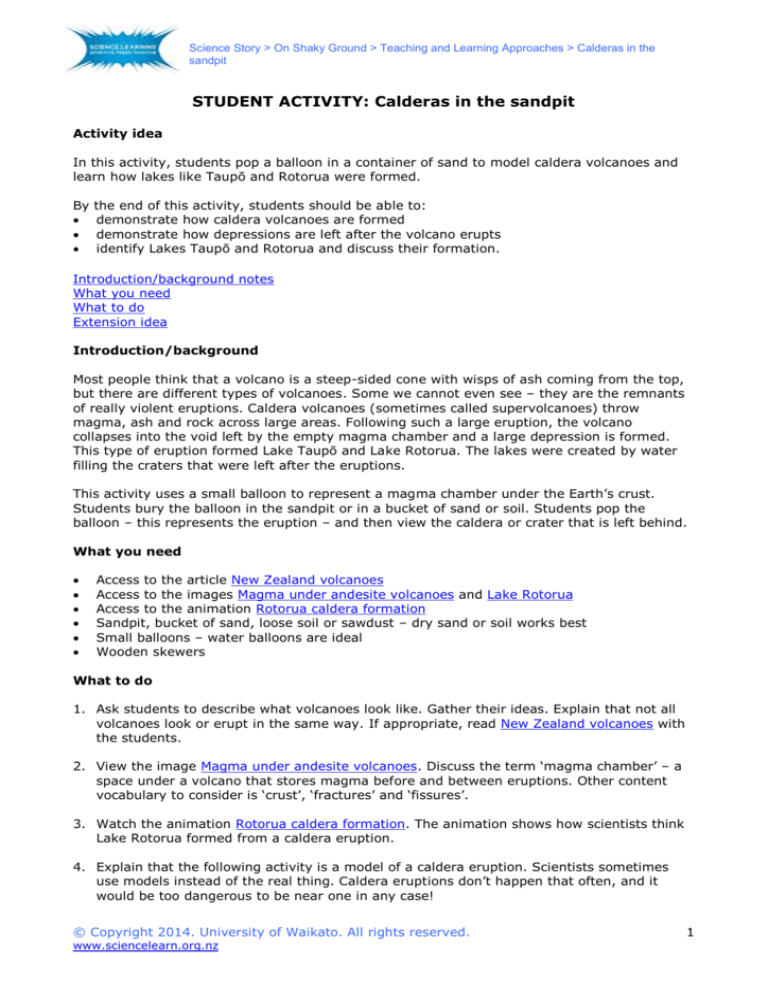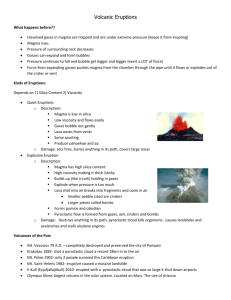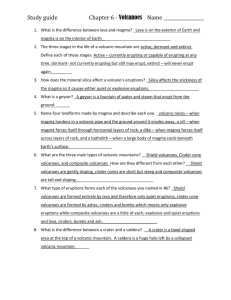
Science Story > On Shaky Ground > Teaching and Learning Approaches > Calderas in the
sandpit
STUDENT ACTIVITY: Calderas in the sandpit
Activity idea
In this activity, students pop a balloon in a container of sand to model caldera volcanoes and
learn how lakes like Taupō and Rotorua were formed.
By
the end of this activity, students should be able to:
demonstrate how caldera volcanoes are formed
demonstrate how depressions are left after the volcano erupts
identify Lakes Taupō and Rotorua and discuss their formation.
Introduction/background notes
What you need
What to do
Extension idea
Introduction/background
Most people think that a volcano is a steep-sided cone with wisps of ash coming from the top,
but there are different types of volcanoes. Some we cannot even see – they are the remnants
of really violent eruptions. Caldera volcanoes (sometimes called supervolcanoes) throw
magma, ash and rock across large areas. Following such a large eruption, the volcano
collapses into the void left by the empty magma chamber and a large depression is formed.
This type of eruption formed Lake Taupō and Lake Rotorua. The lakes were created by water
filling the craters that were left after the eruptions.
This activity uses a small balloon to represent a magma chamber under the Earth’s crust.
Students bury the balloon in the sandpit or in a bucket of sand or soil. Students pop the
balloon – this represents the eruption – and then view the caldera or crater that is left behind.
What you need
Access to the article New Zealand volcanoes
Access to the images Magma under andesite volcanoes and Lake Rotorua
Access to the animation Rotorua caldera formation
Sandpit, bucket of sand, loose soil or sawdust – dry sand or soil works best
Small balloons – water balloons are ideal
Wooden skewers
What to do
1. Ask students to describe what volcanoes look like. Gather their ideas. Explain that not all
volcanoes look or erupt in the same way. If appropriate, read New Zealand volcanoes with
the students.
2. View the image Magma under andesite volcanoes. Discuss the term ‘magma chamber’ – a
space under a volcano that stores magma before and between eruptions. Other content
vocabulary to consider is ‘crust’, ‘fractures’ and ‘fissures’.
3. Watch the animation Rotorua caldera formation. The animation shows how scientists think
Lake Rotorua formed from a caldera eruption.
4. Explain that the following activity is a model of a caldera eruption. Scientists sometimes
use models instead of the real thing. Caldera eruptions don’t happen that often, and it
would be too dangerous to be near one in any case!
© Copyright 2014. University of Waikato. All rights reserved.
www.sciencelearn.org.nz
1
Science Story > On Shaky Ground > Teaching and Learning Approaches > Calderas in the
sandpit
5. Explain that the sandpit or bucket of sand or soil represents the Earth.
6. Hold up a small balloon. This represents the magma chamber. (Consider referring to the
Magma under andesite volcanoes image so students are clear what actual magma
chambers are thought to look like and that they are filled with magma, rather than air.)
7. Dig a hole in the sandpit or bucket of sand or soil. Place the blown up balloon in the hole
and cover it with a layer of 1 - 2 cm dry sand or soil.
8. Use the skewer to pop the balloon. The popping represents the eruption. Air rushes out of
the balloon. With a real volcano, gases, ash and rocks would rush out instead.
9. Observe the crater – or caldera – left behind. Look at the image Lake Rotorua and discuss
how the lake was formed.
10. Repeat the activity, giving students the opportunity to be a supervolcano!
11. Ask students not involved with repeated eruptions to look for images of Lake Taupō on the
internet. How do these images compare with Lake Rotorua?
Extension idea
If students enjoyed making models of caldera volcanoes, consider making models of a cinder
cone. The activity instructions suggest using rice bubbles, but dry sand, soil or sawdust will
work just as well.
Making a model of a cinder cone
© Copyright 2014. University of Waikato. All rights reserved.
www.sciencelearn.org.nz
2








